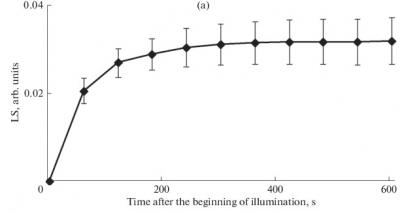Lobachevsky University researchers improve methods for remote monitoring of the condition of crops grown in fields and greenhouses, including the early diagnosis of stress effects on plants

Credit: Lobachevsky University
Currently, agriculture remains one of the most labor-intensive and vital sectors of human activity. For Lobachevsky University scientists, increasing its efficiency is one of their research priorities that requires the development of new methods and approaches, including methods for remote monitoring of the crops.
“In particular, remote monitoring facilitates early detection of stressor-induced damage to plants and localization of the affected area, thus making it possible to apply protection measures only to the affected plants and to do it in a timely manner. The most promising approach to the analysis of the plant status is to measure the reflected light in the visible range, since the reflectivity of the plants is closely related to their physiological and biochemical processes and the measurement of the reflected light is relatively simple from the technical point of view,” says Vladimir Sukhov, Head of the Electrophysiology Laboratory at the UNN Institute of Biology and Biomedicine.
It should be noted that the analysis of the reflection spectra is quite a difficult task, which involves the use of the analysis of spectral reflectance indices. In turn, the reflectance indices are often the ratio of the difference in reflection at two wavelengths (narrow bands) to their sum.
One of such indices is the photochemical reflectance index (PRI), which is calculated based on the reflection of light by the plant at wavelengths of 531 and 570 nm. The use of such index is based on a relatively rapid decrease in reflectance at the wavelength of 531 nm when plants are exposed to adverse factors; this means that the PRI should decrease under the influence of stressors, and this can be used to perform remote monitoring. However, the mechanisms of PRI changes in the first minutes of illumination have not been sufficiently studied, and their elucidation can be of significant fundamental and applied value, as field measurements of photochemical index are performed in the conditions of an unstable illumination by sunlight.
The aim of the research performed by Ekaterina Sukhova, PhD student at the Department of Biophysics, UNN Institute of Biology and Biomedicine, together with her colleagues was to carry out experimental analysis of the mechanisms underlying the PRI decrease after the start of illumination. In particular, the authors analyzed the connection between the changes of photochemical reflectance index and the acidification of the lumen of the chloroplasts exposed to light. This research was supported by the Russian Science Foundation and its results were published in the journal Biochemistry (Moscow), Supplement Series A: Membrane and Cell Biology.
“Such acidification is a key step in the photosynthesis and, thus, in the production processes of plants. To assess lumen acidification, the authors used the changes in light transmission of the plant leaf at a wavelength of 535 nm in the minute range, since these changes are indicative of changes in the pH of the chloroplast lumen,” explains Ekaterina Sukhova.
Photochemical reflectance index was measured using a spectrometer. For this study, pea seedlings and adult plants of geranium were chosen, which are a convenient object for the analysis of lumen acidification and photochemical reflectance index changes.
The study showed that when light was switched on, chloroplast lumen acidification occurred simultaneously with the reduction in PRI of pea and geranium leaves. Both processes developed synchronously during the first 2 minutes of illumination, which was confirmed by the high correlation coefficient between the two parameters studied.
The reverse process, the increase in pH of the lumen and the increase in the photochemical reflectance index occurred when light was turned off; the coefficient of correlation between the values remained high.
For longer intervals (up to 10 minutes), the relationship between changes of the photochemical reflectance index and light transmission at the wavelength of 535 nm became weak; it means that the light transmission changes related to the pH were responsible for the PRI changes.
“On the whole, our results show that the rapid acidification of the lumen of the chloroplasts exposed to light is involved in the development of reduction of the photochemical quenching index in the range of minutes. This result is of fundamental importance to clarify the mechanism of PRI changes under unstable lighting conditions. In particular, it shows that the decrease in the photochemical reflectance index is related not only to the stressor-induced biochemical changes of photosynthetic pigments (such changes require from several minutes to several dozens of minutes), but also to faster processes in the photosynthetic apparatus; possibly it can occur due to compression of chloroplasts caused by acidification of the lumen,” Vladimir Sukhov comments on the results of the study.
From the practical point of view, the results obtained can be used to specify conditions for applying photochemical reflectance index for monitoring the state of plants in unstable conditions of natural lighting or for given illumination intensity changes when growing plants in greenhouses. In the future, this approach can be used to improve the techniques for remote monitoring of the state of crops in the fields and in greenhouses, and to perform early diagnosis of the effect of stressors acting on plants.
###
Media Contact
Nikita Avralev
[email protected]
Related Journal Article
http://dx.




